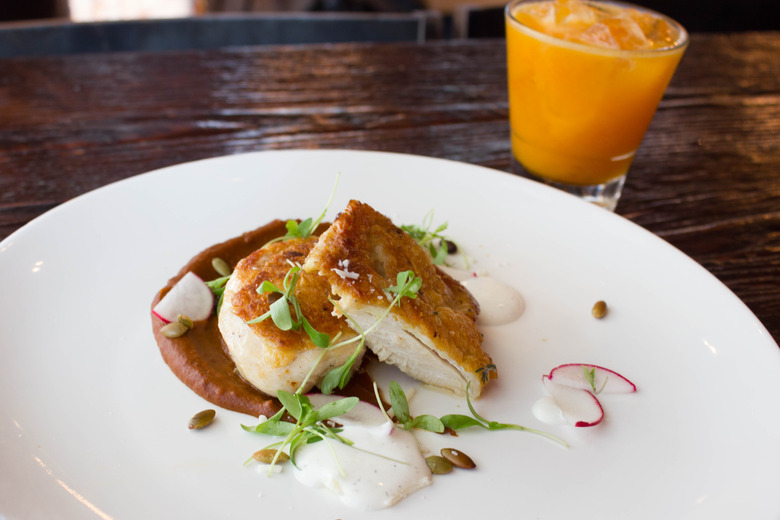Why New York City's Añejo Opts For Fruity Flavors In Cold Months
Usually, fruity flavors and ingredients start to appear on spring and summer menus, but not at Añejo. One fall evening, we were invited into Añejo Tribeca to try the seasonal chicken mole with pumpkin and found a few other sweet surprises we weren't expecting: Tiny octopus tostadas made with a taro puree that is apparently only detectable for certain palates, duck enchiladas, and beef empanadas made with dried cherry.
Let's start with the mole. Too often, we find ourselves spooning our way through heaps of sauce—delicious sauce, but too much of it—to find the drowned piece of chicken, which is just that: a piece of chicken. But the presentation at Añejo is delicate, and the chicken, along with a side of greens, sits perfectly roasted and seasoned on top of the sauce, which is garnished with pumpkin seeds.
"Sweetness in mole is a delicate, intricate, and very important factor. At Añejo, I sweeten my moles – traditional, pumpkin, and chocolate – with dried ancho, mulato, and guajillo chiles. I soak them in in small amounts of piloncillo, an unrefined raw cane sugar," says Ricardo "Ricky" Camacho, culinary director of Añejo and partner of the Sosa Consulting Group. "If you're picking up a dried fruit essence, it's coming from my trusty chiles and piloncillo. While it's similar to its fruit counterparts, I really love the unique sweetness chiles bring."
Camacho grew up in the South Bronx in a loving Puerto Rican family that bonded at the table. On weekend mornings while most kids were watching cartoons, Ricky preferred to watch Julia Child and The Frugal Gourmet on public television, trying to replicate what he had just learned with help from his parents. Determined to follow a creative path, Camacho enrolled in architecture at the New York Institute of Technology and waited tables to help cover tuition. However, he often found himself volunteering in the kitchen. The lure won him over, and he ultimately received his degree from the Institute of Culinary Education.
Tasked with creating the menu for Añejo, he traveled to Mexico, eating his way through Oaxaca and Guadalajara and visiting markets and agave farms to learn about the country's culinary traditions and values.
It was in Oaxaca that Camacho says he noticed that the most delicious, authentic dishes contain darker, bitter flavors.
"This has served as my inspiration, with one modification. In my cooking I like to bring more balance incorporating sweet and bitter. I think this allows the food at Añejo to resonate with a broader New York audience," he says.
Outside the mole realm, he will sometimes end up using dried fruit to add sweetness.
"My picadillo filling for the beef empanadas consists of dried cherries," he says. "While the more traditional route would include raisins I feel that dried cherries are a bit more complex in flavor. They add not only that sweet note, but also a sour one."
A few weeks later, sporting winter jackets and our game faces, we arrived to devour dinner in 45 minutes before seeing a Broadway show, we made an instant decision about where to go for dinner beforehand: Añejo's Hell's Kitchen location on 47th Street, We knew exactly what to order, too: the same exact things we did last time, only swapping the empanadas for tacos al pastor because it is never too cold to sink your teeth into the sweet tropical bliss of pineapple and pork.
It was even better the second time—now, I've got a new favorite spot to add to my roster, and Añejo has a new friend. Me.
For more NYC Restaurant Stories, click here.

